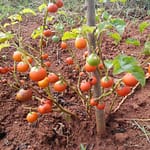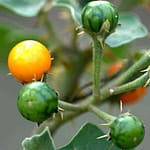Medical Reviewer: Dr Surabhi Rawat
Mom would always tell me that I had a penchant for getting out of difficult situations. Be it getting home late or skipping on that dal chawal (rice and lentils) that was served at our cosy dining table. Regardless of those things, I know one thing that I can always get out of: Drinking homemade ‘kashaya’. Who even likes ‘kashaya?’ It is bitter, dark, filled with coarse powder, and a whole lot of other yuck tasting things. But given that I am an adult and have been for quite some time now, I drink it with a facade of sophistication just so I can be an ideal member in every little one’s eyes. Brihati is one such thing made me go “NO!” at first sight. I really couldn’t understand the significance because the first thing I did was judge the plant by its appearance.
It was quite a day when mom and I saw a prickly plant growing by the side of the road, one that I didn’t want to waste another moment looking at. But mom, being the amazing home-remedy doc that she is, instantly recognized the shrub and squealed, “Brihati!” Cue the clueless expression on my exhausted and uninterested face. Apparently, this dry shrubby plant is treasured in the field of Ayurveda. This made me dive deeper into its history, and imagine the look of surprise on my face when I found out that this little thing made its name in most ayurvedic texts.
Going by the botanical name of Solanum Indicum, this shrub is also known to many as poison berry, Indian Nightshade, Badi Kateri in Hindi and Dovadi, Kuli in Sanskrit.

Geographical Location
Brihati is a plant that flourishes in tropical/subtropical climates all over India. It is easily found in scrublands, on the sides of roads, and places that you least expect an ayurvedic herb to grow in. It is found in areas up to an elevation of 1500 metres.
Ayurvedic Properties
Every ayurvedic herb is described and classified by certain properties and Brihati is also defined within the same boundaries.
|
Rasa (Taste) |
Katu(Pungent), Tikta(Bitter), |
|
Guna(Physical quality) |
Ruksha(Dry), Laghu(Light) |
|
Virya(Potency) |
Ushna(Hot) |
|
Vipaka (Metabolic Property Post Digestion) |
Katu (Pungent) |
|
Dosha Karma(Effects) |
Pacifies Vata Dosha and Kapha Dosha |
Dosha Karmas
Dosha Karma refers to the numerous effects the consumption of the ayurvedic herb has on the human body. And as for the Brihati, there are many.
The Brihati plant has the following actions:
- Subsides nausea
- Increases appetite (Deepan)
- Improves and aids digestion (Pachan)
- Is helpful in pain relief
- Acts as an aphrodisiac
- Wormicidal (Krimighna)
- Pacifies Vata dosha (Vatahara)
- Pacifies Kapha dosha (Kaphahara)
- Acts as a diuretic (Mutral)
- Anti-inflammatory (Shothhar)
- Treatment for throat related issues (Kanthya)
It is also notable that Brihati is a part of the Dashamoola concoction. The Dashamoola refers to a concoction of ten herbs and roots and is known to be strong and effective in treatments. Most ayurvedic scholars are aware of the Dashamoola and study to improve on the constituents as best as they can.

Phytochemical Constituents
The Brihati plant has the following phytochemical constituents that allow for the plant to be effective when used for numerous treatments.
- Solasodine
- Carotene
- Diosgenin
- B–Sitosterol
- Solamargine
- Solanidine
- Lanosterol
Reference In Ayurvedic Texts
In ayurvedic texts, this plant has been named in Charak Samhita in the preparation of Kanthya(used to treat throat disorders), Hikkanigrahana(treatment of hiccups), Shothahara(anti-inflammatory in nature), Angamarda Prashamana(effective in providing relief from pain).
It is also mentioned in Susrutha Samhita in the preparation of Bruhatyadi and laghu panchamula.
Parts Of The Plant Used For Treatment
As for the actual parts of the plant that are used for treatment, the ayurvedic practitioners recommend using the fruit and root for maximum benefits either in powder form or in Kwath or decoction form on a pre-determined dosage based off of the individual’s need, type of metabolism and medical history.
Remedies, Usage And Medicinal Benefits
To cure medical conditions, the plant is used in numerous ways, be it in a consumable form or an externally applicable form.
Treating Asthma, Cough And Bronchitis
Suggested Remedy: About five to six grams of the coarse root powder is mixed into a glass of water. It is brought to a rolling boil and reduced to half a cup. It is then filtered and ready for consumption.
Treatment For Alopecia
An unpredictable autoimmune hair loss disorder, Alopecia is a disease that cripples many when it comes to psychological stress.
Suggested Remedy: This may be treated by applying a mixture of the Brihati fruit and honey externally over the affected areas.
Cough
Suggested Remedy: The fruit of the Brihati plant is pounded into a paste and fried in butter (unsalted and freshly made). The same is consumed orally. In addition to the same, as an alternative preparation, the juice extracted from the root of the Brihati plant is administered to the patient.
Diarrhoea In Infants
Suggested Remedy: The fruit extracts after the removal of the spine are mixed with the mother’s milk and administered to the infants to treat the issues.
Difficulty During Labour
Suggested Remedy: In the event that the patient is experiencing severe discomfort or difficulty while going through labour, the root decoction of the Brihati plant is administered to provide the patient with relief from the pain.
Gastric And Abdominal Problems
Suggested Remedy: The root extract of the plant that is made after grinding the root matter with a rock is mixed with rice water and administered to the patient orally. It is prescribed to be taken twice a day for four to five days. It aids digestion and curbs any such issues.
Intestinal Worms
Suggested Remedy: To battle intestinal worms, the fruit of the plant is to be consumed after the removal of the spine.
Ringworm And Itches
Suggested Remedy: The paste made from the root and fruit of the plant is applied topically over the affected regions to treat the ailments.
Rheumatism
Suggested Remedy: The juice is extracted from the root and fruit of the plant and is administered to the patient.
Scabies
Suggested Remedy: Scabies is treated externally and to do so, the juice is extracted from the fruit and roots of the plant and applied over the patient’s affected areas.
Urinary Tract Related Issues
Urinary tract infections, dysuria, pain, discomfort or difficulty in urination, cease or reduction in the production of urine are not uncommon in people these days.
Suggested Remedy: Such ailments can be treated by taking approximately half a teacup of root decoction twice daily.
Tonic
Suggested Remedy: The root decoction of the Brihati plant is taken as a tonic in controlled dosages to improve the overall health of an individual.
General Uses Of Solanum Indicum
- The Brihati plant is effective as an antioxidant, anti-carcinogen, immunomodulator, neuroprotector, diaphoretic and an expectorant.
- It is one of the finest herbs that is used to treat cold, cough, sore throat and asthma.
- The seeds of the plant are effective in treating dysmenorrhea, amenorrhea and diseases that may arise postpartum.
- It is helpful in relieving abdominal colic pain.
- Effective in treating oedema.
- Beneficial in strengthening the cardiac muscles.
- Helps in treating anorexia.
- It is also used to treat female infertility.
- The juice of this plant can be used to treat gout and earaches.
- It is also very effective in treating neurological disorders.
Recommended Dosage
To prepare a solution/decoction, five to six grams of coarse root powder is mixed into a standard glass of water and brought to a boil. It is reduced to half its initial volume and cooled. The decoction is ready for consumption after straining. The dosage of the decoction is restricted to 30ml, three times a day.
The root and fruit powder have a restricted dosage of two to three milligrams a day.
The fruit may be consumed on its own after the removal of the spine. It can also be ground to a pulp to extract the juice, to consume with honey or to use topically.
The root may also be ground to obtain extracts.
Side Effects & Precautions
The side effects of herbs and naturally occurring medicines rarely come with a lot of side effects, however, it is always recommended that any treatment, be it Ayurveda, homoeopathy or even allopathy be taken after a detailed consultation and a full diagnosis that includes patient medical history.
Brihati may leave a persistent bitter taste in the mouth is taken over a long time.
It is hot in its property and can cause dryness in the body, blisters, hot face and also result in high pitta.
It is for the same reason that a medical/ayurvedic practitioner’s opinion is valuable before self-medication. All good things are only good if only used or consumed in the right proportions and right methods. All those that choose to use the herb are highly recommended to visit a certified medical/ayurvedic practitioner before regularly consuming the herb.
